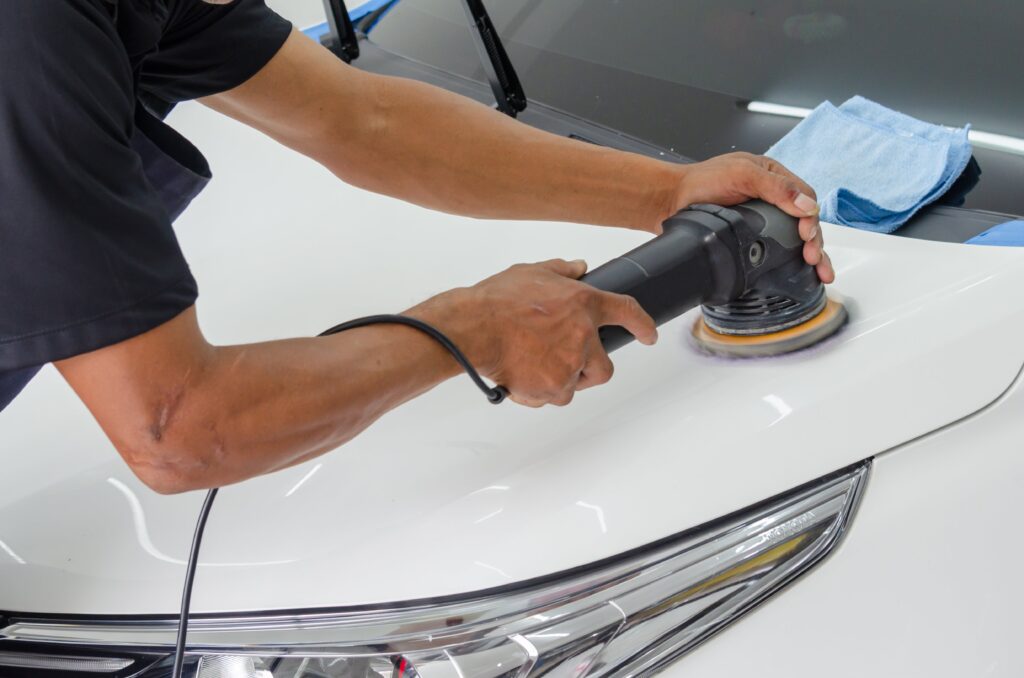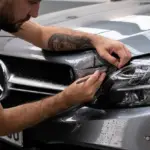
First impressions count, and your car is no exception. Welcome to ‘The Ultimate Guide to Car Polishing: Why It Matters’.
You’ll learn why regular polishing isn’t just about maintaining your car’s glamor, but a crucial part of its upkeep.
You’ll master the art of polishing, understand which tools are right for the job, and become aware of common mistakes to avoid.
Don’t let your car’s shine fade away; instead, let’s keep it gleaming and in great condition with our comprehensive guide.
Understanding the Basics of Car Polishing
Before diving into the techniques, you should understand what car polishing actually is and why it’s an essential part of auto maintenance. At its core, car polishing involves the use of a product, usually a paste or liquid, that contains mild abrasives. These abrasives work to remove a thin layer of your vehicle’s paintwork, eliminating minor surface scratches, oxidization, and other imperfections. It’s not just cosmetic, there’s a functional aspect too. Polishing enhances the longevity of your car’s exterior by providing a protective barrier against environmental elements such as UV rays, rain, and road grime.
Polishing isn’t the same as waxing, though they’re often confused. Waxing provides a protective layer, but doesn’t rectify paint defects like polishing does. It’s crucial to polish before waxing, setting the stage for an immaculate finish.
While it might seem like a job for professionals, you’re perfectly capable of doing it yourself with the right knowledge and tools. It’s a cost-effective way of maintaining the aesthetic appeal of your vehicle and preserving its value. Don’t underestimate the power of a good polish – it’s a game-changer in car maintenance.
Also Read:
- Top 5 Best Cordless Impact Wrench For Changing Tires
- Top 5 Best Jump Starters for Cars
- Top 5 Best Battery for Jeep Wrangler
Importance of Regular Car Polishing
Your car’s appearance and value can significantly benefit from regular polishing, making it an indispensable part of your vehicle’s upkeep. Over time, your car’s exterior endures a barrage of elements, such as dirt, grime, rain, and UV rays, which can lead to dullness, fading, and even chipping. Regular car polishing can effectively counteract these effects, giving your car a brilliant shine and protecting it from further harm.
Moreover, regular car polishing doesn’t just enhance your vehicle’s aesthetics; it also adds to its longevity. The polishing process gently removes a thin layer of paint, eliminating minor imperfections and scratches. This procedure reveals a fresh layer of paint, restoring your car’s original luster.
Lastly, one of the benefits of car polishing is maintaining your vehicle’s resale value. A well-maintained exterior is a clear indicator of a well-looked-after car, impressing potential buyers and possibly fetching a higher price.
Step-by-Step Guide to Polishing Your Car
Now, let’s dive into the step-by-step process of polishing your car, ensuring you’re armed with the knowledge to protect and preserve your vehicle’s exterior.
- Preparation: First, thoroughly wash your car to remove any dirt or debris that could scratch the paint during the polishing process. Use a car-specific soap, not dish soap, which can strip your car’s protective wax coating.
- Polishing: Apply a small amount of polish on a foam applicator pad. Using circular motions, spread the polish evenly over a small area. Don’t rush; take your time to work the polish into the paint.
- Buffing: After the polish has dried to a haze, buff it off using a microfiber cloth. Turn the cloth frequently to avoid reapplying the polish you’ve just removed.
- Inspecting: Finally, inspect the area you’ve polished. If you see any swirl marks or hazing, repeat the polishing and buffing process until you achieve a smooth, mirror-like finish.
Remember, practice makes perfect. Don’t be disheartened if you don’t get it right the first time.
Let’s move on to choosing the right polishing tools to ensure you get the best results.
Choosing the Right Polishing Tools
Having the right tools for car polishing can make all the difference in achieving that perfect shine. It’s not just about grabbing any old cloth and rubbing a little bit of polish on your ride. You need to make sure you’re equipped with the best tools for the job.
Firstly, you’ll need a good quality car polisher. There are two main types: rotary and dual action. Rotary polishers are more powerful but require a bit more skill to handle. If you’re a beginner, you may want to start with a dual action polisher as they’re easier to control and less likely to cause damage.
Secondly, don’t forget about the polishing pads. They come in different levels of aggressiveness, so you’ll need to choose the right one for your car’s paint condition. A softer pad is ideal for a car with minor imperfections, while a more aggressive pad can tackle deeper scratches.
Lastly, the polish itself is crucial. It’s recommended to go for a high-quality polish that’s designed for automotive use. Remember, investing in the right tools can save you time, effort, and even money in the long run. So choose wisely and enjoy that unbeatable shine!
Mistakes to Avoid During Car Polishing
Even with the right tools in hand, it’s easy to make mistakes during the car polishing process that can mar your vehicle’s finish. Here are some common errors you should be aware of:
- Using the Wrong Products: Always ensure you’re using the right products for your car’s paint. Using incorrect or low-quality products can lead to scratches and swirls.
- Incorrect Buffing Speed: Over-buffing at high speeds can cause paint damage. It’s better to start slow, gradually increasing the speed as needed.
- Polishing in Direct Sunlight: This can cause the polish to dry too quickly, making it difficult to remove and potentially damaging the paint. Always polish in a shaded, cool area.
- Not Cleaning the Car Properly Before Polishing: Any dirt or debris left on the car can get caught in the polishing pad, causing scratches. Always wash and dry your car thoroughly before starting the polishing process.
Avoiding these common mistakes will help ensure a smooth, shiny finish for your vehicle. Remember, car polishing isn’t just about making your car look good, it’s also about protecting its paint and increasing its longevity.
Conclusion
So, isn’t it time you give your car the polish it deserves? Remember, regular polishing not only enhances your car’s appearance but also its lifespan. Follow this guide, choose your tools wisely, and avoid common mistakes.
The result? A gleaming, well-maintained vehicle that’s a joy to drive. Car polishing isn’t just a chore, it’s an investment in your vehicle’s future.
Are you ready to put in the work?









